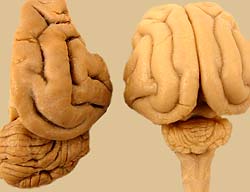Traditionally, the cerebellum has been identified with regulation of muscle tone, posture and movement. This is clearly its major function, particularly in domestic animals. However, visceral organ representation has been detected in different regions of the cerebellum and recent evidence suggests a sensory and even a cognitive role for the cerebellum.
Motor Function:
The cerebellum modulates motor activity by continually comparing motor center intensions with actual performance (as revealed by proprioceptive feedback), and then modifying motor center activity to minimize performance errors. Also, the cerebellum maintains normal posture, including appropriate muscle tone for each type of posture.
Muscle tone is regulated by the cerebellum. Extensive damage to cerebellar cortex (loss of inhibition to fastigial nucleus) results in generalized hypertonus (opisthotonus). Ablation of the cerebellum (nuclei) produces generalized hypotonia.
Vestibular signs result from damage to the flocculonodular lobe of the cerebellum. These signs include nystagmus, wide-based gait, stumbling, and ataxia.
Intentional tremor is seen as an oscillation of particularly the head when it is not at rest on the ground. Head posture cannot be maintained in a stable position for drinking and eating. The tremor appears to represent a deficiency of myotatic reflexes to hold a fixed posture, determined by setting lengths of intrafusal muscle fibers.
Ataxia is the result of malposition of limbs during locomotion, in contrast to the consistent relative placement of limbs during normal gaits. The ataxic animal appears to stagger as it moves; this incoordinations is particularly evident in the hind limbs.
Dysmetria refers to an abnormal range of movement excursion. Usually, cerebellar damage results in hypermetria, manifested by delayed timing and excessive range of movement, e.g., a hypermetric forelimb is lifted too far up, held too long, and then slammed too hard into the ground during locomotion.

Typical Cerebellar Syndrome:
Signs of cerebellar damage include:
• wide-based stance and ataxic gait,
• intention tremor (typically head oscillation),
• hypermetric gait, and sometimes
• nystagmus
Non-motor function:
The cerebellum has a role processing temporal sensory information; cerebellar deficit patients may misjudge an approaching wall and run into it and not respond to a visual menace stimulus. The cerebellum can affect visceral function, for example, cerebellar stimulation can alter heart rate and respiration rate. Also, cerebellar damage can impair cognitive functions, including selective attention and language processing. Cerebellar deficiencies have been associated with dyslexia and psychiatric conditions.